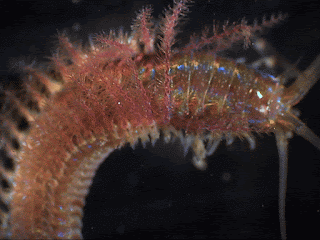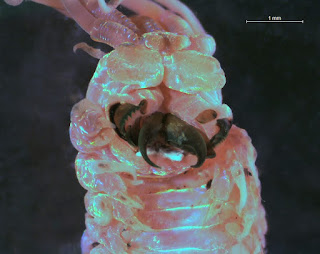Eyes Under Puget Sound's "Critter of the Month"
June
is LGBTQ+ Pride Month, and in the spirit of celebrating diversity—both
invertebrate and human—we’re
featuring a critter that wears its rainbow colors with pride every day of the
year. Meet one of Puget Sound’s most beautiful creatures: the
ornate tube worm, Diopatra ornata.
 |
Diopatra ornata collected from subtidal
sediments at Nisqually Reach.
|
Breathe with me
Like many other species of polychaetes, or marine segmented worms, D. ornata has gill structures called branchiae on each segment, which help pull oxygen from the
surrounding water and sediment. In D.
ornata, the branchiae are distinctly spiraled and look like frilly trees or
ferns running down either side of its iridescent body. The bright red color of
the branchiae comes from the blood vessels inside—if
you look closely at the live worm, you
can see them expanding and contracting to help
circulate blood throughout the body.
Fancy digs
The
“ornate” parchment-like tube of a Diopatra
worm gets its name, and decorative appearance, from the bits of shells and
algae attached to the hook-shaped top end, which projects from the sediment
surface. Although only a few centimeters of tube are exposed above the sand,
the buried portion may extend down as much as a meter!
The
tube’s adornments, which the worm sticks on with mucus, not only serve as camouflage
from predators, but also encourage small animals to colonize the outside. In
some parts of D. ornata’s range,
especially off the central California coast,
the tubes occur in great densities, forming mats that provide complex habitat
for macroalgae (seaweed) and other animals. The little communities of organisms on the
outside of the tubes may also serve as a built-in snack bar when the worms get
hungry.
|
Left: A shell-covered Diopatra
ornata tube protrudes from sandy sediment (photo courtesy of Kevin Lee,
www.diverkevin.com). Right: This tube has been dug up, showing the bare end
that stays buried in the sand (photo courtesy of Jeff Adams, Washington
SeaGrant).
|
Jaw-dropping
 |
|
Ventral (bottom) close-up of a preserved
Diopatra ornata specimen with its jaws extended. |
Scientists disagree on what D. ornata’s favorite food is—perhaps because it likes them all! It is perfectly happy munching on detritus (organic matter), but can also grab pieces of seaweed or small invertebrate prey in its rather fearsome black jaws. It has no eyes, but can sense the world with five long antennae attached to its head.
Diopatra like to build their tubes in sand rather than fine mud, so in Puget Sound, we see them most frequently where the sediment is coarse, such as around Nisqually Reach and East Anderson Island. So next time you’re walking on the beach at low tide and spot a large debris-covered tube sticking out of the sand, chances are you’ve encountered the home of one of these ornate beauties!
By Dany Burgess & Angela Eagleston, Environmental Assessment Program
Diopatra like to build their tubes in sand rather than fine mud, so in Puget Sound, we see them most frequently where the sediment is coarse, such as around Nisqually Reach and East Anderson Island. So next time you’re walking on the beach at low tide and spot a large debris-covered tube sticking out of the sand, chances are you’ve encountered the home of one of these ornate beauties!
By Dany Burgess & Angela Eagleston, Environmental Assessment Program
Critter of the Month
Our benthic
taxonomists, Dany and Angela, are scientists who identify and count
the benthic (sediment-dwelling) organisms in our samples as part of our Marine Sediment
Monitoring Program. We track the numbers and types of species we see
in order to understand the health of Puget Sound and detect changes over time.
Dany and Angela share their discoveries by bringing us a Benthic Critter of the Month. These posts will give you a peek into the life of Puget Sound’s least-known inhabitants. We’ll share details on identification, habitat, life history, and the role each critter plays in the sediment community. Can't get enough benthos? See photos from our Eyes Under Puget Sound collection on Flickr.
Dany and Angela share their discoveries by bringing us a Benthic Critter of the Month. These posts will give you a peek into the life of Puget Sound’s least-known inhabitants. We’ll share details on identification, habitat, life history, and the role each critter plays in the sediment community. Can't get enough benthos? See photos from our Eyes Under Puget Sound collection on Flickr.




No comments:
Post a Comment